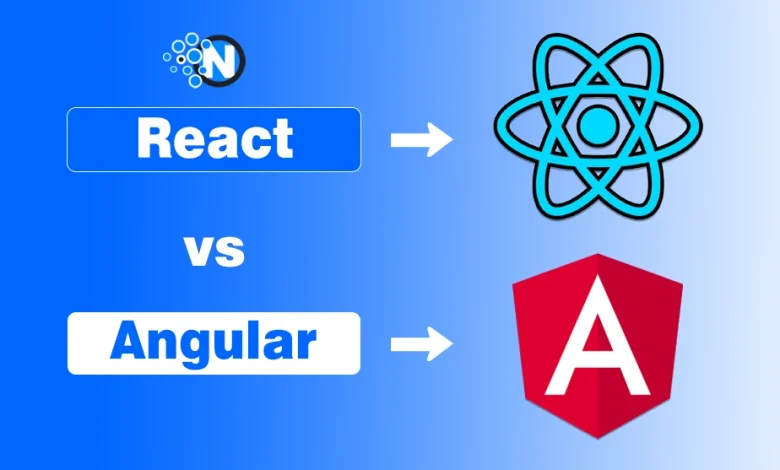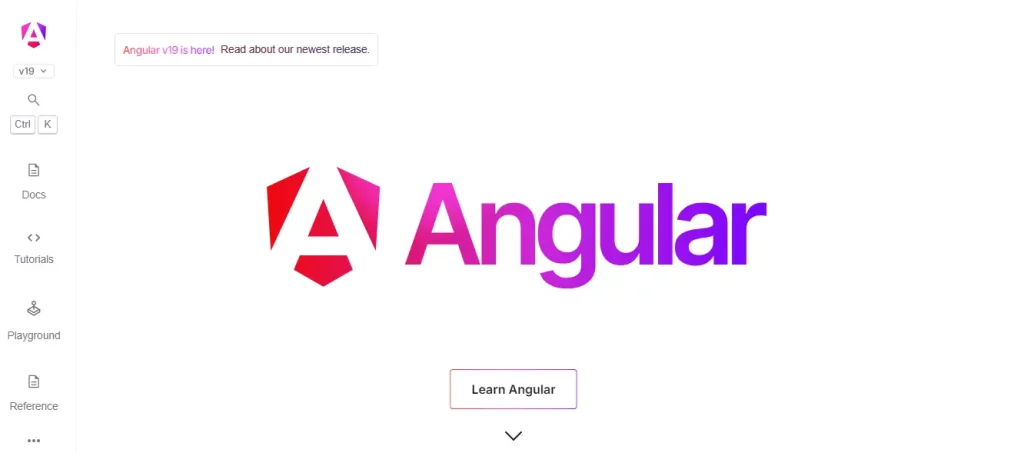React vs Angular – Key Features and Differences

Whenever it comes to choosing a front end framework or library, people often get confused in the React vs Angular battle. Both these powerful tools can be the best picks for your upcoming project. However, they are distinct in their functionality and approach.
Therefore, it is necessary to understand both and determine which can be the best solution according to your requirements and preferences. In this blog post, I have highlighted the key features and differences of both these tools.
Overview of React and Angular
In the under section, I have provided a general overview of both platforms so that it can make the ground to determine the React vs Angular battle dominator.
1. React
Facebook has developed the React and is currently maintaining it. It is a JavaScript library that is primarily used to build user interfaces. Generally, it focuses on the View layer of the Model View Controller architecture.
React has gained worldwide popularity for its flexible nature and efficient functioning. Thus, you can create dynamic interfaces and web applications. The following are the key features of this tool.
- Component-Based Architecture: Applications are broken down into reusable components.
- Virtual DOM: Ensures fast and efficient updates to the UI.
- Unidirectional Data Flow: Simplifies debugging and state management.
- Rich Ecosystem: Integrates well with third party libraries for routing, state management, and more.
- JSX Syntax: Allows developers to write HTML and JavaScript together.

2. Angular
Angular is developed and maintained by Google. It is a comprehensive front end framework that is based on TypeScript. It offers complete solutions to build single page applications, shortly known as SPAs.
As this platform offers all solutions, it is the top priority for the organizations and enterprises that are looking forward to building their applications. The following are its key features.
- Two Way Data Binding: Synchronizes data between the model and the view automatically.
- Dependency Injection: Simplifies the management of services and components.
- Comprehensive Toolset: Comes with built in features like routing, forms, and HTTP services.
- TypeScript Based: Enhances code maintainability and provides advanced development tools.
- Modular Architecture: Facilitates scalability and maintainability.

React vs Angular – Key Differences
While both platforms deliver massive advantages, they differ from each other in several aspects. Here are some of them.
1 – Philosophy and Learning Curve
- React: React is just a library, not a full framework. It provides the flexibility to choose additional libraries and tools based on the requirements of your project. This approach lets you use more tools. However, you have to learn them as well before using them. Besides, the developers need to understand JSX and state management tools.
- Angular: Angular is a complete framework that provides everything you need out of the box. Its comprehensive nature means developers have to follow the conventions and patterns of this platform. The learning curve is steep as developers should learn key concepts like modules, RxJS, and decorators for reactive programming.
2 – Architecture
- React: React focuses solely on the View layer. You have to integrate other libraries for routing such as React Router and state management tools like Redux or MobX.
- Angular: On the other hand, Angular follows a Model View Controller architecture. It provides built in solutions for different purposes. These include routing, forms, HTTP requests, and state management. Hence, it is a complete solution.
3 – Data Binding
- React: One of the best parts of React is that it uses unidirectional data flow. In this approach, the state flows in one direction only. As a result, the behavior of the application becomes more predictable and easier to debug.
- Angular: Angular implements the two way data binding strategy. It automatically synchronizes the model and the view. Although it simplifies the data management, there may be several performance issues in the complex applications.
4 – Performance
- React: As I mentioned about Virtual DOM above, it ensures efficient updates to the user interface in React. You have to make changes first in the virtual DOM. Only the differences in the real DOM are visible.
- Angular: The change detection mechanism checks of the Angular platform review the complete component tree to bring updates to the DOM. While it is true that it ensures consistency, it can directly impact the performance in larger applications.
5 – State Management
- React: React offers multiple options for state management. These include built in Context API and third party libraries like Redux and MobX. This flexibility allows developers to choose the best tool for their specific needs.
- Angular: Angular not only includes built in state management features but also supports external libraries like NgRx. Hence, you can carry out more complex state management requirements.
6 – Community and Ecosystem
- React: With a massive community and extensive ecosystem, React has a wealth of third party libraries, tools, and resources. It is widely acceptable for both small scale and large scale applications.
- Angular: Conversely, Angular has a strong community, especially in enterprise development. However, its ecosystem is smaller and has tools and libraries owned by Angular.
| Features | React | Angular |
|---|---|---|
| Type | Library | Framework |
| Developed By | ||
| Language | JavaScript with JSX | TypeScript |
| Architecture | Focuses on the View layer (MVC) | Full fledged MVC architecture |
| Data Binding | Unidirectional | Two way |
| State Management | Requires third party libraries (e.g., Redux) | Built in and supports NgRx |
| Performance | Virtual DOM for efficient rendering | Change detection with AOT compilation |
| Learning Curve | Moderate | Steep |
| Community and Ecosystem | Extensive third party library support | Comprehensive built in tools |
| Use Cases | SPAs, dashboards, eCommerce platforms | Enterprise level applications, SPAs |
What to Choose Between React vs Angular?
Now, that you have learned about React vs Angular, it is now time to determine what to choose between them. Several factors are there you should consider before making a decision. These include the requirements of your project, the expertise of the team, and scalability needs. Nevertheless, I have shared some of my insights below as well.
Choose React if:
- You need flexibility and prefer a library over a full framework.
- Your application demands high interactivity and custom solutions.
- You have a team experienced in JavaScript.
Choose Angular if:
- You value out of the box features.
- You are building a large scale, structured application.
- Your team is familiar with TypeScript and prefers a comprehensive solution.
Final Thoughts
These are the details about React vs Angular and their key features along with differences. Both platforms have their own set of strengths and disadvantages. Thus, it is extremely challenging to choose between them. That’s why you have to understand them properly to make a well informed decision.
React is best when it comes to flexibility. Thus, you can use it for smaller projects. On the other, the comprehensive nature of Angular makes it a brilliant choice for enterprise level applications. Just determine the requirements of your project and you will end up making the right pick.




